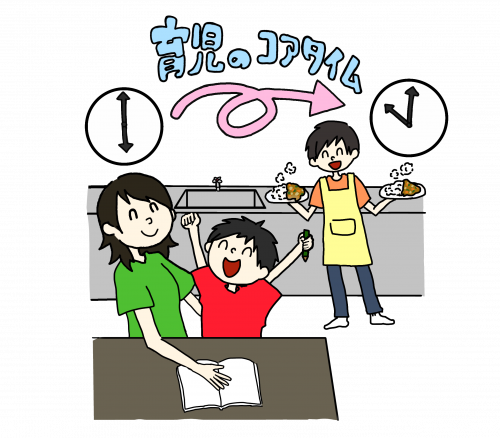
Mothers suffering from not being able to work the same way they did before giving birth
One of the most common concerns of women returning to work after a parental leave is the worry about their careers. Many mothers have time constraints and are unable to work the same way they did before giving birth. Under these circumstances, it is natural for them to feel anxious. Many mothers are worried that they will not be given the same level of work as before, or that they are no longer being relied upon, etc. I often hear mothers say that they are inconveniencing their workplaces, or that they feel sorry for those around them.
In addition, many husbands want to share childcare responsibilities, but are having trouble sharing the responsibility because their workplaces lack understanding and consideration for male childcare. For example, for women, there is a “Are you sure you don’t need to go home early?” for women, but not for men. This leads to a situation where men want to go home early to bathe their children, but they are not able to do so.
Unconscious bias that working moms tend to have
When I talk about career development after childcare leave at lectures and seminars, the mothers who attend are surprised to hear that they can work in a way that maintains their careers after the birth of their children.
That is how many women think that they have no choice but to give up their careers to some extent and save their work after taking childcare leave. Due to the unconscious bias that says “child-rearing is a woman’s job,” women are making it hard on themselves by assuming that they are the ones who are supposed to take care of the children.
As shown in Tokyo’s “100 Episodes of ‘Unconscious Assumptions’ Based on Gender” ( https://www.seikatubunka.metro.tokyo.lg.jp/danjo/wlb_top/0000001780.html), a mother who works shorter hours when her child has a fever and she is in a hurry to take time off to take care of him is a typical example of unconscious bias. When her child developed a fever, she was in a hurry to take time off to take care of her child, and was surprised when her father told her that he would take a paid day off.
In addition, in some companies, all women who return to work after childcare leave work on shortened working hours. In such a work environment, some people, even those who are actually able to work full time, may assume that since everyone else has shorter hours, it is only natural that I should return to work with shorter hours as well. In order to expand your potential, it is an important step to recognize the unconscious bias that is causing you to give up or shy away from your career. Returning to work after childcare leave can be a chance to confront the unconscious bias that has been holding you back.
After 6:00 p.m., “core childcare time” to spend with children.
Many mothers are concerned that returning to work will mean that they will have less time to spend with their children, but rather than thinking about increasing the amount of time they spend together, it is important to devise ways to spend time. I consider the period from 6:00 pm to 10:00 pm to be the “core time” for childcare on weekdays. Ideally, at least one member of the couple should spend that time with the children. Unlike adults, children do not separate playtime from mealtime and bathtime, so all the time spent with mom and dad is fun playtime.
Then, consider “skipping” household chores to spend more time with your children. For example, cook without hassle and use the time to enjoy the meal. If your dad is a better cook, you can ask him to do it. Introducing convenient appliances is another way to “skimp”. By working together as a couple and facing the children during “core child-rearing time,” the anxiety and burden of child-rearing can be lightened.

Have an honest discussion with your partner.
Recently, an increasing number of fathers in their 20s and 30s want to participate in child rearing once their children are born. I believe that if we have a frank discussion about each other’s views on child-rearing without the assumptions and judgments I have mentioned so far, we may discover new things about the other person.
It is also important to make your partner fully aware of your desire to work and your wishes regarding your work style. If you think “I want to return to work full time from the beginning for career advancement” or “I don’t want to work shorter hours for a long period of time,” do not assume that it will be impossible and do not speak up, but first let your partner know your thoughts. In fact, I have heard of one case where, after discussing work after childcare leave, the husband worked shorter hours and the wife returned to work while keeping her full time job. Many families are now devising their own ways to share household chores, which would have been unthinkable in Japan not long ago, so I think it is important to share your true feelings and create your own unique way of doing things.
The key to returning to work is “readiness to balance work and family” and “advance preparation.
We often hear from mothers after childcare leave that they are afraid that they will not be able to be kind to their children when they return to work and will hit them. To prevent this from happening, it is important to be prepared to “never take out stress on your children. To this end, make preparations in advance for emergencies. Sudden fevers or illnesses in children are bound to happen. Ideally, you should think in advance about what you will do in such cases and have as many options as possible, such as relying on each other’s parents, siblings, or babysitters in addition to yourself and your partner. It is also important to save on household chores by using household appliances and housekeeping services.
If you are sharing childcare with your partner or each other’s parents, we also recommend implementing an information-sharing application. A calendar application that allows you to share work schedules and daycare schedules and quickly decide who will handle them would be useful.
Work with a mindset of “early” rather than “perfect.”
We have been advocating to companies for more than 10 years to have a meeting with your supervisor before you give birth and before you return to work. If you want to work the same way after childcare leave as before, clearly present your rationale for time constraints, such as what time you would like to arrive at work in the morning because you have to drop off your child at daycare, and gain your supervisor’s understanding. Then, when negotiating to increase the number of telecommuting days, for example, you need to clearly explain your wishes and the benefits to the company, such as the elimination of commuting time and increased productivity.
What I also want you to be aware of when working immediately after your return to work is to turn your work around as soon as possible, even if it is only 70% to 80% complete, rather than aiming for 100% completion. While time is limited and sudden events are likely to occur, such as a child running a fever, it is important to have a relaxed approach to work, for example, to turn around the PDCA (plan, do, evaluate, and improve) cycle as early as possible. To this end, it is important to prioritize your work and handle it in a proper order of priority. Also, be aware that you should “visualize” your work to make it easier to hand over to others.
The age of 100 years of life. There will always be a chance to make up for it!
Balancing work and childcare is a long process that continues all the way up until the child is 18 or 20 years old. The most difficult time is right after you return to work, when your child is small and in need of your help. Even if you hit a wall or have trouble, don’t give up. If you look at your future in the medium to long term, 5 to 10 years from now, you will have a chance to make up for lost time after you have settled down to raise your child, Think of your life as 100 years, and take your time without worrying or rushing.
I hope that learning about Unconscious Bias will be one of the reasons why you can look back later and think that your awareness at that time had a positive effect.
Rie Yamaguchi / Post Maternity Leave Consultant®.
Engaged in software development at a general electronics manufacturer. After taking maternity leave in 2010, she became an independent consultant. Provides consulting services and seminars for employees to companies, government agencies, and municipalities to promote women’s activities. She is currently training future generations in the post-paternity leave advisor training course. For individuals, she runs the “Post-Independence Leave Café®” as a place where people can talk about their careers after childcare leave in peace, and holds the “Post-Independence Leave Café Facilitator Certification Course” to provide a place where working mothers and fathers can think and learn together. She is the author of “Revised Edition: Let’s Start After Childcare Leave: Cheering Song for Working Mothers” (Labor Research Institute) and “Communication to Make the Most of Employees with Child Care: A Collection of Hints for Ikubosu” (Labor Research Institute).









